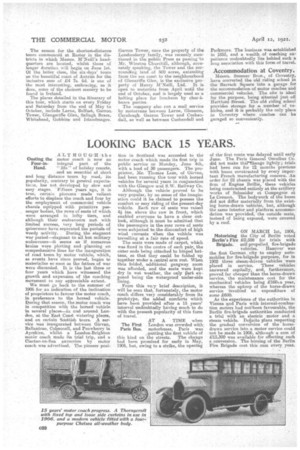LOOKING BACK 15 YEARS.
Page 24

If you've noticed an error in this article please click here to report it so we can fix it.
ALT HOUG'11 the Ousting the motor coach is now an Four-inintegral part of the Hand. "life" of holiday resorts, and an essential of short and long distance tours by road, its popularity, contrary to general expecteflees, has not developed, by slow and easy stages. 'Fifteen years ago, it is true, certain pioneers made valiant efforts to displace the coach and four by the employment of commercial vehicle chassis equipped with primitive passenger bodies, the rows of seats of which were arranged in lofty tiers, and although their endeavours met with limited success, very long periods of quiescence have separated the periods of weedy activity. During the stagnant war period—stagnant to all but military endeavours—it seems as if numerous brains were plotting and planning on compeehenlsive lines for the inauguration of road tours by motor vehicle, which, as events have eince proved, began to materialize so soon as the fetters of war were discarded. It is the last three or four years which have witnessed the growth and expansion of the coaching movement. to any appreciable extent.
We must go back to the suinmer of
1906 for an indication of the inclination of proprietors to favour the motor coach, in preference to the horsed vehicle. During that season, the motor coach was in competition with the horsed vehicle in several places—in end. around London, at the East Coast Watering places, and on certain Soottish tours. A service was inaugurated between Girvan, Ballantree, Colmonell, and Penwherry in Ayrshire, whilst a London-Brighton motor coach made its trial trip, and a Clacton-em-Sea excursion by motor coach was advertised. The pioneer posi tion in Scotland was accorded to the motor icoexth which made its first trip in public service on Monday, June 4th, with a load of 30 passengers. The proprietor, Mr. Thomas Lees, of Girvan, had been running this tour with horsed vehicles for several years in conjunction with the. Glasgow and S.W. Railway Co.
Although the vehicle ,proved to he very popular, by no sense of the imagination could it be claimed to possess the (=fort or easy riding of the present-day vehicle. Each row of Beate was raised 41 ins, above the row in front, which enabled everyone to have a clear Outlook, although it must be admittedthat the passengers in the rear rows of seats were subjected to the discomfort of high wind currents When the vehicle was travelling at a fair rate of speed.
The seats were made of carpet, which was fixed in the centre of each pair, the outer ends being attached to hinged battens, so that they could be folded up together under a central arm rest. When thus folded, additional gangway room was afforded, and the seats were kept dry in wet weather, the only fart exposed being the waterproof under-side lining.
From this vey brief description, it will be seen that fortunately, the motor coach differs very considerably from its pretotyPe, the Wed cemforts which have been provided after a 15 years' interval undoubtedly having much to do with the present popularity of this form of travel.
AT A TIME when The First London was crowded with Paris Bus. motorbuses, Paris was :ruitting the first vehicle of this kind on the streets. The change had been promised for early in May, 1906, but, owing to a strike, the opening of thw first route was delayed until early June. The Paris General Omnibus Co. did not make thigMbange lightly; trials had been run for 12 months previous with buses constructed by every important French manufacturing concern. An order for 22 chassis was placed with the firm of Eugene Praia, ' these vehicles being constructed entirely at the artillery works of Schneider et Compagnie at Le ,Creusot. The bodywork of the buses did not differ materially from the existing horse-drawn vehicles, but, although the same interior and platform accommodation was provided, the outside seats, instead of being exposed, were covered by a roof.
ON MARCH 1st, 1906, Motorizing the City of Berlin voted Berlin's Fire £2,500 for trials with Brigade, self-propelled fire-brigade
vehicles. Hanoverwas the first German city to employ automobiles for fire-briga3e purposes, for in 1902 three steam-driven vehicles were placed in service. These vehicles answered capitally, and, furthermore, proved far cheaper than the horse-drawn service, the maintenance cost• for the mechanical vehicles being £l00.a year, whereas the upkeep of the horse-drawn service involved an expenditure of some £600.
As the experience of the authorities in Vienna and Paris with internal-combustion motors had notlbeen favourable, the Berlin fire-brigade anthorities conducted a trial with an electric motor and a steam vehicle. Definite plans respecting the gradual conversion of the horsedrawn service into a motor service could not be made in 1906, although a sum of • £15,300 was available for effecting such a conversion. The horsing of the Berlin Fire Brigade cost this sum every year.
































